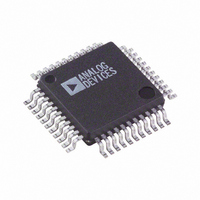AD7865BSZ-1 Analog Devices Inc, AD7865BSZ-1 Datasheet - Page 15

AD7865BSZ-1
Manufacturer Part Number
AD7865BSZ-1
Description
4 CH. SIMULTANEOUS BIPOLAR,14-B ADC I.C.
Manufacturer
Analog Devices Inc
Datasheet
1.AD7865AS-2REEL.pdf
(19 pages)
Specifications of AD7865BSZ-1
Number Of Bits
14
Sampling Rate (per Second)
350k
Data Interface
Parallel
Number Of Converters
1
Power Dissipation (max)
160mW
Voltage Supply Source
Analog and Digital
Operating Temperature
-40°C ~ 85°C
Mounting Type
Surface Mount
Package / Case
44-MQFP, 44-PQFP
Lead Free Status / RoHS Status
Lead free / RoHS Compliant
Available stocks
Company
Part Number
Manufacturer
Quantity
Price
Company:
Part Number:
AD7865BSZ-1
Manufacturer:
ADI
Quantity:
364
Company:
Part Number:
AD7865BSZ-1
Manufacturer:
Analog Devices Inc
Quantity:
10 000
Part Number:
AD7865BSZ-1
Manufacturer:
ADI/亚德诺
Quantity:
20 000
Company:
Part Number:
AD7865BSZ-1REEL
Manufacturer:
Analog Devices Inc
Quantity:
10 000
When operating the AD7865 in a standby mode between con-
versions, the power savings can be significant. For example,
with a throughput rate of 10 kSPS and external reference, the
AD7865 will be powered up 11 µs out of every 100 µs (1 µs for
wake-up time and 9.6 µs to convert four channels. Therefore,
the average power consumption drops to (115 mW × 10.6%) or
12.2 mW approximately.
OFFSET AND FULL-SCALE ADJUSTMENT
In most Digital Signal Processing (DSP) applications, offset and
full-scale errors have little or no effect on system performance.
Offset error can always be eliminated in the analog domain by
ac coupling. Full-scale error effect is linear and does not cause
problems as long as the input signal is within the full dynamic
range of the ADC. Invariably, some applications will require
that the input signal span the full analog input dynamic range.
In such applications, offset and full-scale error will have to be
adjusted to zero.
Figure 13 shows a typical circuit that can be used to adjust the
offset and full-scale errors on the AD7865 (V
version is shown for example purposes only). Where adjustment
is required, offset error must be adjusted before full-scale error.
This is achieved by trimming the offset of the op amp driving
the analog input of the AD7865 while the input voltage is
1/2 LSB below analog ground. The trim procedure is as follows:
apply a voltage of –610 µV (–1/2 LSB) at V
amp offset voltage until the ADC output code flickers between
1111 1111 1111 and 0000 0000 0000.
Gain error can be adjusted at either the first code transition
(ADC negative full scale) or the last code transition (ADC posi-
tive full scale). The trim procedures for both cases are as follows.
INPUT
RANGE =
500
10k
10k
R2
R3
R1
ADDITIONAL PINS OMITTED FOR CLARITY
V
1
10V
R5
10k
CONVST
BUSY
STBY
10k
R4
V
AGND
INxA
AD7865
1
t
1
BUSY
and adjust the op
7 s
on the AD7865-1
100 s
I
DD
= 3 A
Positive Full-Scale Adjust
Apply a voltage of 9.9982 V (FS/2 – 3/2 LSB) at V
until the ADC output code flickers between 01 1111 1111 1110
and 01 1111 1111 1111.
Negative Full-Scale Adjust
Apply a voltage of –9.9998 V (–FS + 1/2 LSB) at V
R2 until the ADC output code flickers between 10 0000 0000
0000 and 10 0000 0000 0001.
An alternative scheme for adjusting full-scale error in systems
that use an external reference is to adjust the voltage at the V
pin until the full-scale error for any of the channels is adjusted
out. The good full-scale matching of the channels will ensure
small full-scale errors on the other channels.
DYNAMIC SPECIFICATIONS
The AD7865 is specified and 100% tested for dynamic perfor-
mance specifications as well as traditional dc specifications such
as Integral and Differential Nonlinearity. These ac specifications
are required for such signal processing applications as phased array
sonar, adaptive filters and spectrum analysis. These applications
require information on the ADC’s effect on the spectral content
of the input signal. Hence, the parameters for which the AD7865
is specified include SNR, harmonic distortion, intermodulation
distortion and peak harmonics. These terms are discussed in
more detail in the following sections.
Signal-to-Noise Ratio (SNR)
SNR is the measured signal-to-noise ratio at the output of the
ADC. The signal is the rms magnitude of the fundamental.
Noise is the rms sum of all the nonfundamental signals up to
half the sampling frequency (f
dent upon the number of quantization levels used in the digitization
process; the more levels, the smaller the quantization noise. The
theoretical signal to noise ratio for a sine wave input is given by
where N is the number of bits.
Thus for an ideal 14-bit converter, SNR = 86.04 dB.
Figure 14 shows a histogram plot for 8192 conversions of a dc
input using the AD7865 with 5 V supply. The analog input was
set at the center of a code transition. It can be seen that most of
the codes appear in the one output bin, indicating very good
noise performance from the ADC.
SNR = (6.02N + 1.76) dB
t
WAKEUP
t
BUSY
S
/2) excluding dc. SNR is depen-
AD7865
1
1
. Adjust R2
and adjust
REF
(1
)













